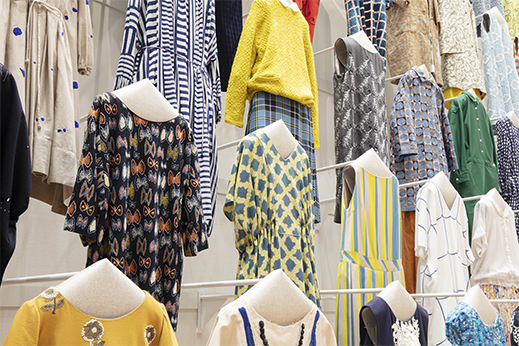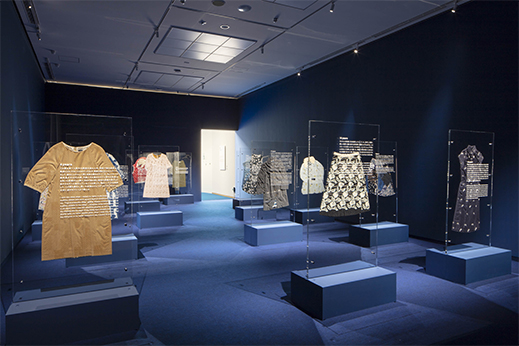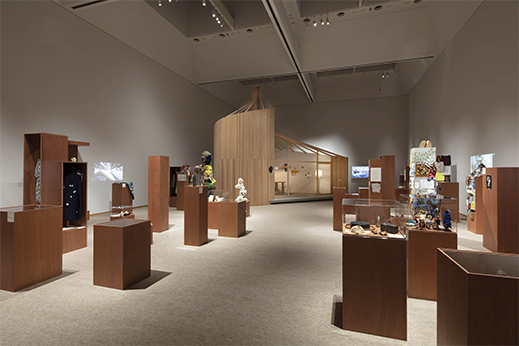 |
Focus features two in-depth reviews each month of fine art, architecture, and design exhibitions at art museums, galleries, and alternative spaces around Japan. |
|
|
 |
 |
 |
Float Like a Perhonen: The Fashion World of Akira Minagawa
Christopher Stephens |
 |
tambourine (2000-01→AW), a work based on the eponymous motif. |
Launched in 1995 by the designer Akira Minagawa, minä perhonen initially concentrated on clothing and textiles, but after branching out into furniture and tableware, it has come to stand for an entire lifestyle. Commemorating the fashion brand's 25th anniversary, the TSUZUKU exhibition, first presented at the Museum of Contemporary Art Tokyo and currently on view at the Hyogo Prefectural Museum of Art in Kobe, is divided into eight sections with titles like "Kaze [Wind]: Life and Design" and "Ne [Roots]: Drawings," illustrating various aspects of Minagawa's wide-ranging activities.
The first section, Tane (Fruit), a room with rounded yellow walls and an arched entryway, is given over to the "tambourine." This circular motif, made up of 25 irregular dots based on a freehand sketch, is embroidered in fabric using 6.93 meters of thread. A long roll of cloth, measuring 13.7 meters in length and embossed with 6,760 tambourines, is then fashioned into garments, bags, chair seats, and other accessories, a sampling of which are affixed to the walls of the gallery. The motif exemplifies minä perhonen's core concepts of continuance and universality, and its emphasis on humanity over technology -- the needle follows the hand, not the other way around.
 |
|
The "Tane [Fruit]: tambourine" section, focusing on the tambourine motif. Photo: Fuminari Yoshitsugu |
The exhibition title also translates to "continue," suggesting everything from perseverance to an ongoing link between creator and user, materials and nature. When Minagawa (born in Tokyo in 1967) started the brand, he set out to make something that would endure for at least 100 years. Among Minagawa's early inspirations was Scandinavian design, especially that of Finland, a country he first visited at 19. It is no coincidence, then, that the name minä perhonen is derived from the Finnish words for "I" and "butterfly." The word "perhonen," added to the brand's name in 2003, refers to Minagawa's delicate approach and his desire to imbue his work with the beauty of a butterfly wing. Over the years, he has frequently worked with artisans from northern European countries, most notably textile manufacturers like the Danish company Kvadrat and the Swedish Klippan.
The next gallery, another much larger round space, is lined with several tiers of women's wear (dresses for the most part, but also coats and sweater-and-skirt outfits), which reach up to the ceiling. As the title of this section, Mori (Forest), implies, once inside we find ourselves immersed in a grove of "trees," dating from every stage of Minagawa's career. Without any titles or dates to distract us, we are free to roam where our eyes take us, flitting back and forth amid a sea of colors and patterns. With over 400 items, there are far too many designs to absorb, but we catch sight of a summery dress flecked with slivers of light and dark blue, which on closer examination prove to be waves buoying several competitive swimmers through the water. Another dress, red with a simple wide neck and short angled armholes, is ornamented with a jumble of pinkish brushstrokes, forming rough-edged crosses and Xs. Elsewhere, Y-shaped trees, whitish and brown, stand tall amid a snow flurry covering a black coat; two orange rabbits commune on a luminous blue skirt beneath a sweater sprouting diamond-shaped tufts of many-hued thread; and vertical rows of spiny green cacti, pointing both up and down, line a light green dress with elbow-length sleeves.
 |
|
Women's wear in the "Mori [Forest]: pieces of clothes" section. Photo: Fuminari Yoshitsugu
|
If there's a constant among the clothes, it's the straight cut of the pieces, uncinched except for the occasional tie belt. The idea here is not so much to show off the female physique as to supply a lovingly designed, tastefully decorated garment that is practical and comfortable yet still stylish. This explains the generation-spanning appeal of the minä perhonen brand -- a point that is stressed later in the exhibition in a series of short videos, showing women of all ages going about their daily activities. One teaches children ballet in Tokyo, another makes wine in Yamagata, and two more run restaurants in Paris and Okinawa respectively. The clothes in each setting harmonize with the natural tones of the scenery and accentuate the handmade quality of the work without calling attention to themselves.
Minagawa is as dedicated to longevity as he is indifferent to current trends. He makes things that last and remain a part of the user's life. Toward the end of TSUZUKU there is a section titled Tsuchi (Soil) which, unlike the rest of the show, is dimly lit and somewhat cramped. Here we find a dozen or so items borrowed from consumers, who volunteered the use of their clothes on the brand's website, displayed upright between acrylic panels. The works are captioned with a time period ("8 years," "19 years," etc.) followed by a short text recounting the user's memories of the garment. One woman remembers wearing a dress, called friend, to her son's elementary school entrance ceremony in the hope that he would make many friends there, while another recalls buying a dress, adorned with a simple butterfly pattern, just before she adopted a kitten and went to see a friend's newborn baby. These are clothes that become active participants in our lives.
 |
|
The "Tsuchi [Soil]: memory of clothes" section. Photo: Fuminari Yoshitsugu |
Other sections of the exhibition focus on the drawings, paintings, and prints that serve as a foundation for the brand's products (many devised by in-house designer Keiko Tanaka); the process of developing an idea into a working motif, which frequently involves artisans of various kinds; and Minagawa's illustrations for serialized newspaper stories. There are also notebooks, mounds of fabric scraps, a collection of buttons and other knickknacks, and a full-scale tiny house called shell house. A collaboration between Minagawa and the architect Yoshifumi Nakamura, this last work was inspired by the Fibonacci spiral found in seashells and other natural elements.
Though the exhibition was not conceived with the current era of anxiety in mind, it is unquestionably reassuring. In part, this has to do with Minagawa's holistic approach and compassionate vision, but there's also something in the air -- a feeling of hope that comes from the visitors themselves. You get the sense that, beyond the gloom, the creative impulse and better instincts of humankind will eventually prevail.
 |
|
The "Tane [Seed]: idea and study" section, with shell house visible in the background. Photo: Fuminari Yoshitsugu |
All photos provided by The Asahi Shimbun. |
 |
 |
Christopher Stephens
Christopher Stephens has lived in the Kansai region for over 25 years. In addition to appearing in numerous catalogues for museums and art events throughout Japan, his translations on art and architecture have accompanied exhibitions in Spain, Germany, Switzerland, Italy, Belgium, South Korea, and the U.S. His recent published work includes From Postwar to Postmodern: Art in Japan 1945-1989: Primary Documents (MoMA Primary Documents, 2012) and Gutai: Splendid Playground (Solomon R. Guggenheim Museum, 2013). |
|
 |
|